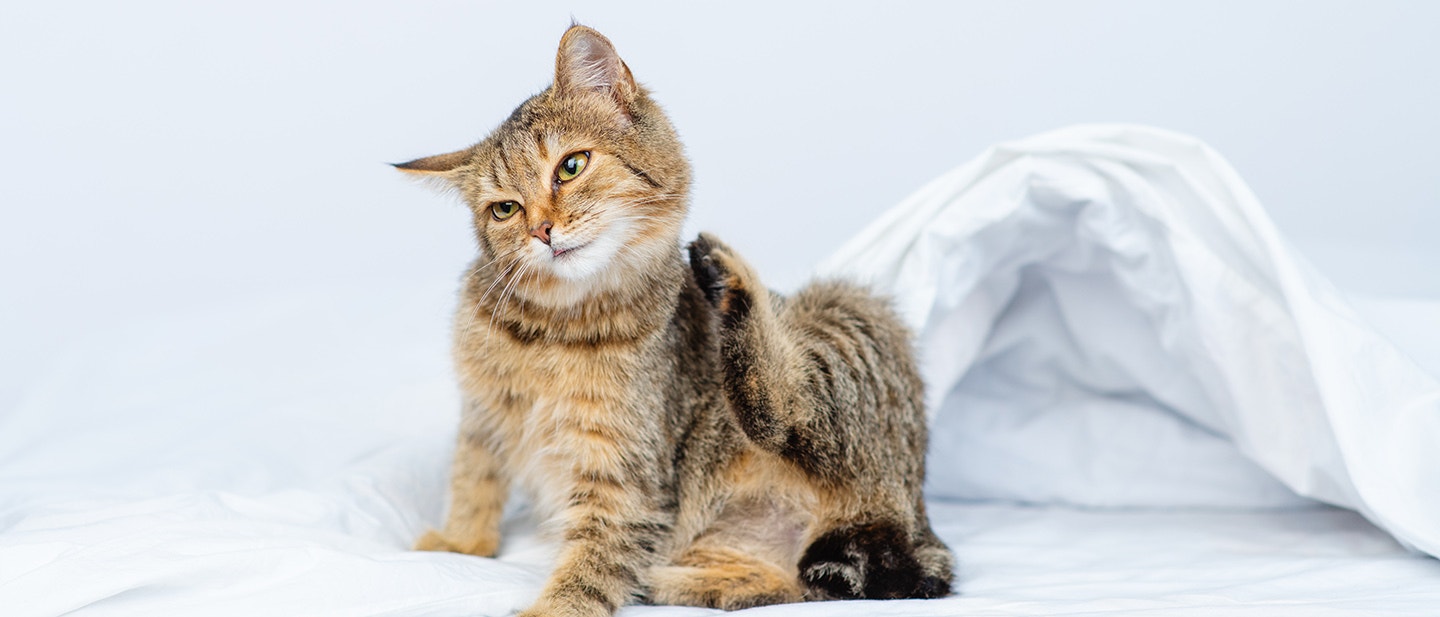
CAN INDOOR CATS GET FLEAS?

Article checked by a vet
When letting your cat outside or thinking about taking your cat for a walk, it's essential to take the risk of fleas, ticks and other parasites into consideration.
But can indoor cats get fleas, too? While many pet owners believe indoor cats are safe from fleas, this is a common misconception. Keeping a cat indoors may reduce exposure to certain dangers, but it doesn't eliminate the risk of fleas or other parasites.
Fleas, ticks and other pests can still find their way into your home and onto your pet, leading to potential health concerns for your cat. Understanding the risks associated with fleas, even for indoor cats, is essential for all cat owners.
So, how do cats get fleas when they don't go outside? Fleas can enter your home in various ways, regardless of whether your pets go outdoors. Other pets that do venture outside, such as dogs, can bring fleas back into the house. Even people can unknowingly carry fleas inside on their clothing, shoes or bags. Additionally, fleas can be transported through the laundry or by entering through small openings like doors and windows. Once inside, these fleas may infest your indoor cat.
The risks associated with fleas are not limited to mere itching and discomfort. Fleas can cause serious health issues, including flea allergy dermatitis, tapeworm infections and anaemia.
Therefore, cat owners must proactively prevent and manage flea infestations to protect their indoor cats from these potential health hazards. For more information on flea treatment for indoor cats and how to get rid of fleas, there's a comprehensive guide covering flea identification and management on the Perfect Fit website.
Do indoor cats need flea treatment?
If you're wondering if you need to use preventative flea treatments on your indoor cat, the answer is yes — indoor cats also need flea treatment as a preventative measure. Preventive care is vital in avoiding the discomfort and potential health risks associated with flea infestations.
There are hundreds of different flea treatments available — with some being more effective than others! So, be sure to seek the advice of your vet or local pet shop to buy an appropriate solution for your cat and home.
Flea collars, topical treatments and oral medications are useful for keeping your indoor cat flea-free. These treatments help to eliminate existing fleas and prevent new infestations, ensuring your indoor environment remains safe for your cat.
Topical solutions are applied directly to the cat's skin and kill fleas on contact, while oral medications work from the inside out to eliminate fleas.
Flea collars are also a popular and effective form of flea treatment for indoor cats. These collars are designed to continuously release active ingredients that repel or kill fleas on contact. One of the significant advantages of flea collars is their long-lasting protection. Unlike topical treatments that may need to be reapplied every month, many flea collars can protect for several months. Flea collars are also relatively easy to use. Once fitted around the cat's neck, they begin to work immediately, offering hassle-free protection.
Additionally, environmental controls, such as vacuuming regularly and regularly washing the cat’s bedding, help to reduce the risk of infestation in your home. Environmental control strategies are particularly beneficial for preventing fleas in indoor cats.
However, it's important to consult a veterinarian before starting any flea treatment to understand the possible side effects and choose the best option that meets your cat’s needs and is safe for their age and body weight.
Do indoor cats get fleas?
While you may think cats will only get fleas if they venture outside, the truth is indoor cats do get fleas, too.
In fact, studies have shown that flea infestations are not uncommon in indoor cats. According to a study published in the Journal of Feline Medicine and Surgery, up to 30% of indoor cats have been found to have fleas at some point. This highlights the importance of regular monitoring and prevention, even for cats that never go outside.
So, how can an indoor cat get fleas? Here are some common scenarios in which indoor cats might pick up fleas:
- Other pets. Pets that go outdoors, such as dogs, can easily bring fleas into the home.
- Human carriers. People can carry fleas into the home on their clothing, shoes or bags.
- Infested items. Fleas can be brought into the home on infested items, such as used furniture or carpets.
- Small openings. Fleas can enter the home through small openings, such as windows and doors.
- Catteries and vets. Indoor cats can come into contact with fleas if they have a trip to the vets or a stay at a cattery.
Can an indoor cat get fleas?
An indoor cat can indeed get fleas under certain conditions. Fleas are often transferred from visiting pets or areas recently treated for fleas, which may still harbour these pests. While keeping a cat indoors limits exposure to many other parasites, fleas can sustain and spread indoors — especially in favourable conditions like warm, humid environments.
Fleas have a rapid lifecycle, and once they enter a home, they can quickly reproduce and spread. Eggs laid by adult fleas can hatch in carpets, upholstery or bedding, leading to a full-blown infestation. Fleas can also be introduced via infested furniture or human clothing, highlighting the importance of vigilance in preventing these pests from entering your home.
To reduce the risk of fleas, simple procedures, including regular vacuuming and washing your pet's bedding frequently, will help. Indoor cats do also need flea treatment, so use flea-preventive methods recommended by your veterinarian.
How do cats get fleas when they don't go outside?
Even indoor cats can get fleas through indirect transmission routes. Fleas can latch onto humans, other pets or infested items, making their way into your home. Therefore, despite their limited exposure, it's important to monitor indoor-only cats for signs of fleas, such as scratching, skin irritation or overgrooming.
You should also regularly check their coat for fleas or flea dirt, which looks like tiny black specks in the cat's fur. If you’re unsure if the specks are flea dirt, place them on a damp kitchen towel; fleas consume blood from mammals, so the dirt will ooze red.
When your kitten or cat is allowed outside, they are at an even greater risk of fleas due to increased exposure to other animals and environments. Even cats that only occasionally venture outside are more susceptible to getting fleas. One of the major risks is from sharing the environment with wild animals that carry fleas, such as foxes, rabbits, hedgehogs and rats.
Routine grooming is an effective early flea detection method because it allows cat owners to inspect their pets regularly for signs of flea infestation. Grooming not only helps maintain a cat's coat and skin health but also serves as a proactive measure to identify fleas or flea-related symptoms before they escalate into a more significant problem.
Flea control provides several long-term benefits for both cats and their owners, extending beyond just the immediate relief from itching and discomfort. Implementing a consistent flea control regimen can significantly improve the overall health and well-being of your cat while also contributing to a healthier home environment.
Natural methods are typically safer and more environmentally friendly, while chemical treatments offer quick, long-lasting and comprehensive flea control. A balanced approach that combines both methods, tailored to the specific needs of your cat and household, can provide the best results. Always consult your veterinarian to determine the most appropriate flea control plan for your pet.
Typically, a monthly flea treatment is recommended, but it's crucial to follow the manufacturer’s guidelines for using the product as these can vary significantly. Consistent flea control helps prevent infestations and protects your cat's health, as well as the home environment, from potential flea-related issues.
Getting rid of fleas on your indoor cat
Unfortunately, indoor cats can get fleas. Fleas can enter homes in various ways, posing significant health risks to your pets. Preventative care, regular monitoring and proper flea treatment are essential to protect indoor cats from flea infestations. More information on identifying and how to get rid of fleas is available on the Perfect Fit website.
